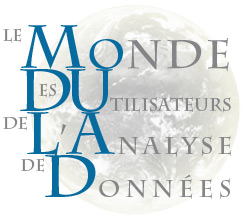Comparison of linear modularization criteria using the relational formalism, an approach to easily identify resolution limit
In EGC 2015, vol. RNTI-E-28, pp.203-214
Abstract
The modularization of large graphs or community detection in networks is usually approached as an optimization problem of a quality function or criterion, for instance, the modularity of Newman-Girvan. There exist other clustering criteria, with their own properties leading to different solutions. In this paper we present six linear modularization criteria in relational notation such as the Newman-Girvan modularity, Zahn-Condorcet, Owsi´nski- Zadro˙zny, the Deviation to Uniformity index, the Deviation to Indetermination index and the Balanced- Modularity. We use a generic version of Louvain algorithm to approach the optimal partition of the criteria with real networks of different sizes. We found that those partitions present important differences concerning the number of clusters. The relational formalism allows us to justify these differences from a theoretical point of view. Moreover, this notation allows to easily identify the criteria having a resolution limit (a phenomenon which causes the criterion to fail to identify modules smaller than a given scale). This finding is confirmed in artificial benchmark LFR graphs.

